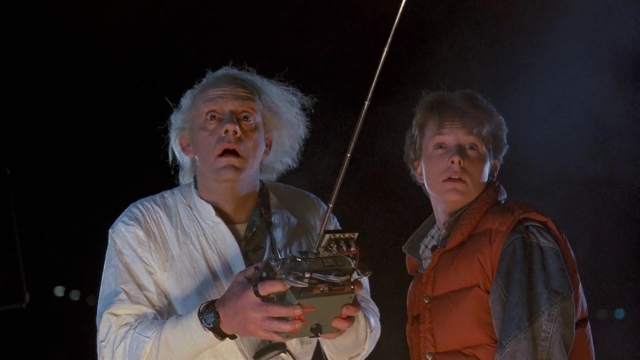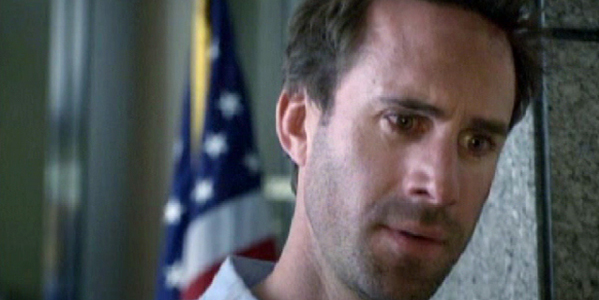Revisiting Back to the Future on Blu-Ray, it’s hard not to get sucked into an infinite regress the likes of which would probably have pleased screenwriters Robert Zemeckis and Bob Gale: the 1985 original, viewed 25 years later, has acquired layers of unintended convolution, discovery, and loss.
As with any smartly-executed time travel story (see: La Jetee, Primer, Timecrimes, and “City on the Edge of Forever”), the plot gets you thinking in loops, attentive to major and minor patterns of similarity and difference, playing textual detective long before Christopher Nolan came along with the narrative games that are his auteurist signature. And BTTF is nothing if not a well-constructed mousetrap, full of cleverly self-referential production design, dropping hints and clues from its very first frames about the saga that’s about to unfold. (Panning across Doc Brown’s Rube-Goldberg-esque jumble of a laboratory, the camera lingers on a miniature clock from whose hands a figure hangs comically, in a shoutout both to Harold Lloyd in Safety Last! [1923] and to BTTF’s own climax.) In this sense, it’s a film designed for multiple viewings, though the valence of that repetition has changed over the quarter-century since the film’s first release: in the mid-eighties, BTTF was a quintessential summer blockbuster, its commercial life predicated on repeat business and the just-emerging market of home rentals. Nowadays, the fuguelike structure of BTTF lends itself perfectly to the digitalized echo chamber of what Barbara Klinger terms replay culture and the encrusted supplementation of making-of materials sparked in the random-access format of DVDs and fanned into a blaze by the enormously expanded storage of Blu-Rays. (Learning to navigate the interlocked and labyrinthine documentaries on the new Alien set is like being lost on the Nostromo.)
But in 1985, all this was yet to come, and BTTF’s bubbly yet machine-lathed feat of comic SF is all the more remarkable for maintaining its innocence across the gulf of the changing technological and economic contexts that define modern blockbuster culture. It still feels fresh, crisp, alive with possibilities. If anything, it’s somehow gotten younger and more graceful: expository setups that seemed leaden now trip off the actors’ tongues like inspired wordplay, while action setpieces that seemed unnecessarily prolonged — in particular, the elaborate climax in which a time-traveling DeLorean must intersect a lightning-bolt-fueled surge of energy while traveling at exactly 88 miles per hour — now unspool with the precision of a Fred Astaire dance routine. Perhaps the inspired lightness of BTFF is simply a matter of contrast with our current blockbusters, which have grown so dense and heavy with production design and ubiquitous visual effects, and whose chapterized storyworlds so entangled with encyclopedic continuity, that engaging with them feels like subscribing to a magazine — or a gym membership.
BTTF, of course, is a guilty player in this evolution. Its two sequels were filmed back-to-back, an early instance of the “threequelization” that would later result in such elephantine letdowns as the Matrix and Pirates of the Caribbean followups. But just as the story of BTTF involves traveling to an unblemished past, when sin was a tantalizing temptation to be toyed with rather than a buried regret, the reappearance of the film in 2010 allows us to revisit a lost moment of cinema, newly pure-looking in relation to the rote and tired wonders of today. For a special-effects comedy, there are surprisingly few visual tricks in evidence: ILM’s work is confined to some animated electrical discharges, a handful of tidy and unshowy matte shots, and a motion-controlled flying-car takeoff at the end that pretty much sums up the predigital state of the art. Far in the future is Robert Zemeckis’s unfortunate obsession with CGI waxworks a la The Polar Express, Beowulf, A Christmas Carol, and soon — shudder — Yellow Submarine.
As for the Blu-Ray presentation, the prosthetic wattles of old-age makeup stand out as sharply as the heartbreakingly unlined and untremored features of Michael J. Fox, then in his early 20s and a paragon of comic timing. It makes me think of how I’ve changed in the twenty-five years since I first saw the movie, at the age of 19. And somewhere in this circuit of private recollection and public viewing, I get lost again, with both sadness and joy, in the temporal play of popular culture that defines so much of my imagination and experience. The originating cleverness of BTTF’s high concept has been mirrored and folded in on itself as much by the passage of time as by Universal’s marketing strategies, so that in 2010 — once an inconceivably far-flung punchline destination for Doc Brown in the tag that closes the film and sets up its continuation in BTTF 2 — we encounter our own future-as-past, past-as-future: time travel of an equally profound, if more reversible, kind.


